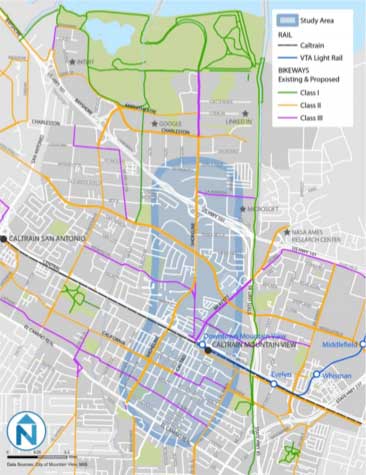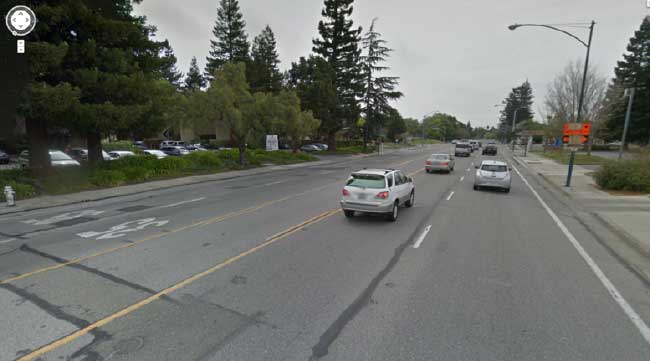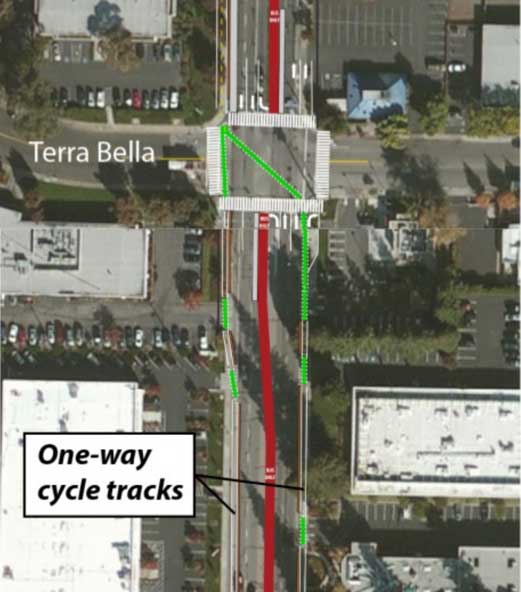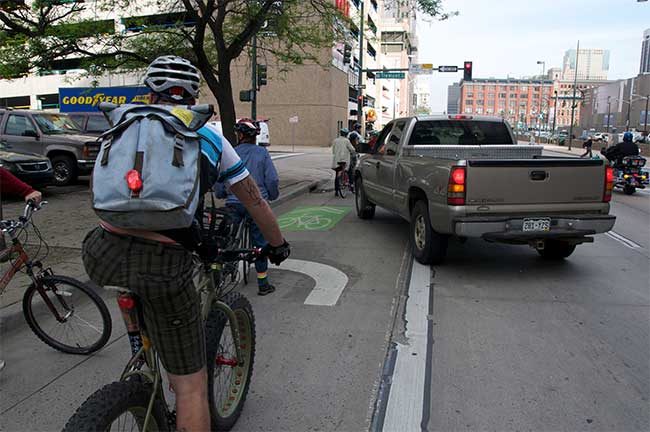Proposals for Cycle Tracks are emerging throughout the Bay Area, and that is generally good news for bicycle safety. But as the saying goes, the devil is in the details. The field of cycle track design in the U.S. remains in its infancy, and as such, the guidance and precedents for effective designs remains limited – opening the door for misinterpretation and problematic designs. These design challenges are especially evident in suburban settings in which high vehicle speeds and frequent curb cuts exacerbate vehicle-bicycle conflicts and elevate the risk of right hook crashes – a unique scenario that is usually absent in modern Dutch cycle tracks (which represent the international standard for best practices).
The City of Mountain View’s ongoing Shoreline Boulevard Transportation Corridor Study illustrates how the introduction of cycle tracks in a suburban setting may, at best, result in marginal safety improvements, or, at worst, exacerbate existing safety risks.
The City is examining transit and bicycle improvements to Shoreline Boulevard between Downtown Mountain View, which features a Caltrain and VTA Light Rail Station, and the North Bayshore area, a major employment hub that is home to Google, LinkedIn, and other tech companies. It is a corridor that already experiences relatively strong bicycle traffic and has a high potential for growth.
The current design of Shoreline Boulevard is focused around moving cars at high speeds. Although Shoreline Boulevard currently has bike lanes, they are narrow (halfway in the gutter), poorly visible, and provide little separation or security from cars. The 35 MPH speed limit, combined with frequent driveways, poses a key safety risk to both bicyclists and pedestrians: drivers routinely turn into parking lots or intersecting streets at high speeds without adequately slowing down to check their surroundings. As we all know, speed kills, so a key objective for a safer, more bike-friendly Shoreline Boulevard starts with traffic calming.
Despite a clear need for traffic calming, a discussion of vehicle speeds is strangely absent from the project’s first Study Session Memo presented to the City Council in June. The memo offers a high-level examination of cycle track and transit concepts, recommending the study proceed with more detailed designs for one-way cycle tracks and a bicycle/pedestrian bridge over US-101 as illustrated by the conceptual diagram below:
Given that the memo represents a preliminary analysis, we can take its contents with a grain of salt (more detailed designs will follow in the next phase). But the memo and accompanying diagram introduce some problematic cycle track concepts by not mentioning the need to reduce vehicle speeds:
1. Mixing zones at high-speed intersections
The memo states: “One-way cycle tracks would better facilitate right-turning vehicles at intersections because the design could accommodate a traditional mixing/transition zone.” The memo is referring to the mixing approach recommended by the NACTO Guide, in which cycle tracks are discontinued at intersections and merged into a mixing zone for bikes and turning vehicles. However, mixing zones are not considered international best practice: they are commonly misconstrued as a Dutch design, but in reality the Dutch have stopped using this approach in favor of a variety of safer measures.
The trouble with the mixing zone approach is that bicyclists abruptly emerge from a protected environment into a shared space with cars, which creates a potential for conflicts and errors among both parties. The primary benefit of cycle tracks – physical protection as opposed to paint – spontaneously disappears at what is the most chaotic point of a street. If feasible, protected intersections or dedicated bicycle signals can address this issue.
This brings us to a key point: the cycle track mixing zones are very risky on streets with high vehicle speeds. Mixing zones may not be optimal, but they can function okay on streets with vehicle speeds below 25 MPH. On a 35 MPH thoroughfare like Shoreline Boulevard, a cycle track mixing zone is unprecedented and potentially dangerous. Such a design gives both parties a false sense of security: for drivers and bicyclists transitioning from complete separation to mixing at high speeds, it leaves little margin of error. To add to the confusion, the concept diagram depicts a scenario in which drivers must drive across the bike lane to a new turn pocket while bicyclists must stop in that same location and wait for a separate signal phase. To paraphrase transit planner Jarrett Walker, such a configuration represents “symbolic safety” – it gives the appearance of a safe design, but in reality it offers bicyclists little protection from a speeding car.
2. Driveways
The conceptual cycle track approach at driveways is similarly cause for concern: the risk of high-speed right hook crashes remains high if only paint and signage are provided. Few cycle tracks have been implemented on high speed arterials in the U.S. with curb cuts as frequent and heavily utilized as Shoreline Blvd. To provide adequate safety at driveways, Dutch engineers typically elevate the driveway to the cycle track to create a speed table, and may also expand the buffer between the cycle track and roadway. But the best way to ensure safety for bicyclists (and pedestrians) is for cars to travel at reasonable speeds: cycle tracks, frequent driveways, and high speed traffic don’t mix.
The question becomes: aren’t these issues also present on bike lanes? The answer is yes, but bike lanes at least provide a more familiar, predictable configuration and interaction between drivers and bicyclists. For cycle tracks, there is a perception amongst both parties that separation means safety, and as such, one may lower his/her level of alertness ever so slightly. To suddenly transition from a point of full separation to a mixing zone or driveway creates a less predictable contrast in configurations, whereas a bike lane is relatively more predictable. To be clear: cycle tracks offer a superior product than bike lanes, but an in-between configuration on a high-speed arterial is highly problematic.
This post doesn’t intend to pick on the City of Mountain View – cities across the country are trying to figure out the same issues, and there isn’t always detailed guidance available. It’s easy to critique projects at such a high level; it’s likely that the City and its consultant, Nelson Nygaard, will address these issues as they develop more detailed designs.
Nevertheless, the lesson is worth repeating: cycle tracks still need traffic calming to be successful. The implementation of cycle tracks on high speed arterials with frequent driveways offers little reduction in conflict points compared to a bike lane; it may even exacerbate conflict points and provide a false sense of security. Such a design is a misinterpretation of what makes cycle tracks successful: the continuous separation of vehicles and bicyclists, featuring predictable movements and a wide margin for error that allows for simple mistakes. Traffic calming is therefore critical on Shoreline Boulevard to establish a margin for error and ensure that all users can travel safely.





